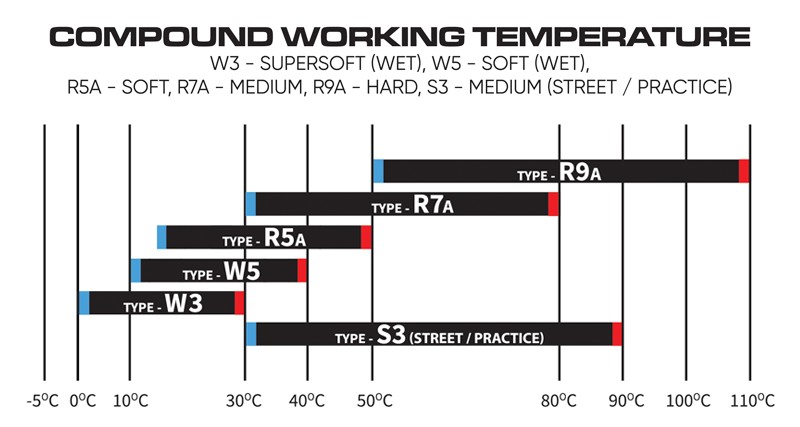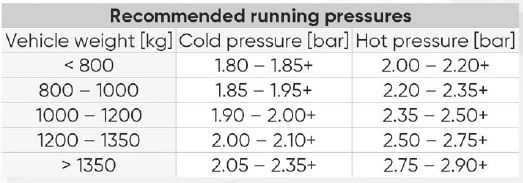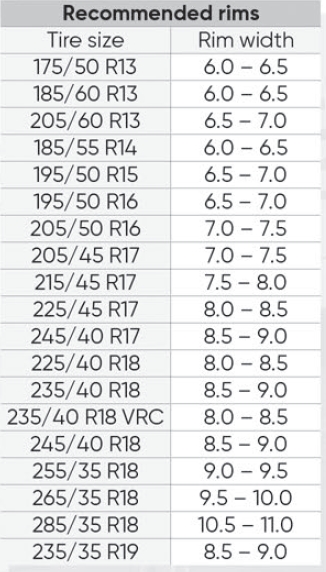All Extreme Tyres have been designed for competition use and even though they are road legal, they are not intended for everyday use and driving on public roads. The „E1” homologation confirms that the tyres meet safety standards, however, they should not be used outside of their intended use, as this may result in unexpected loss of vehicle control which may result in a crash, serious personal injury or even death.
TYRE BREAK-IN PROCEDURE
Proper break-in will increase the competetive life of the tyre and also has a positive effect on the initial tyre performance.
The procedure can broken down into two phases:
1. The initial run – first kilometers are critical for setting up the durability of a tyre. The first session on a new tire should last not more than 10-15 minutes of running. The early part of the session should be run at an easy pace, with the speed gradually increased until the end of the session, so you reach around 90% of the maximum pace on the last lap / last kilometers of the stage and achieve the maximum temperature of the tyre at the same time. At this point the car should be brought in and the tyres should be allowed to cool down at a normal rate.
The goal is to reach the maximum operating temperature, without „shocking” the tyre, so no wheelspin, no burnouts, no late braking or sliding. We advise to increase the inflation pressure by 0.3-0.5 bar during the initial run, compared to what you would normally use.
2. The curing time - after completing the initial run, it is critical to allow the certain amount of time for the tyre to set. The barest minimum for this proces to be benefitial is 24 hours, but the best practice is to leave the tyres unused for a whole week. Although it may seem like a long time, you need to remember that tyre management is a difficult process and the increased durability and extended competetive life is the payoff. We strongly encourage to take your time and complete this process.
COMPOUND WORKING TEMPERATURES
The range of temperatures in which all our rubber compounds are designed to operate is described below:
WARNING! The above chart relates to the temperature of the rubber compound on the tyre, not to the air temperature. It's a very common mistake to select your tire basing solely on the air temperature.
- air temperature,
- track/road temperature,
- surface type,
- car weight and it's weight distribution,
- tyre size and model,
- suspension and geometry setup,
- circuit / stage length and characterictics,
- driving style.
In order to have a perfect match of compound, all of the above needs to be considered, not only the air temperature. For example only, our R7A (medium) compound can get considerably overheated even on a cold 0°C day, in a heavy, poorly balanced, 250 hp car with stock suspension and geometry and an aggressive driver, whereas the same compound may works flawlessly on a hot 35°C day, in a light, perfectly balanced, 160 hp car with a proper suspension and geometry setup and a sensitive style of driving (not to be mistaken with slow).
It's not recommended to leave a parked car on hot tyres, as it may result in gettin additional vibrations comming from compound deformations in the spot contact. We advise to jack up the car or take the whole wheels off.
CHASSIS SETUP RECOMMENDATIONS
The rules of setting the suspension and its geometry up can be completely different depending on the type of car (FWD, RWD, 4x4), engine placement, weight distribution, the general purpose of the car (rally, racing, drift) and even the driver's preferences for a particular track/stage. Because of that, it is not possible to indicate just one correct setting and it should always be consulted with a professional. Incorrect setting of the suspension and geometry results in an uneven wear of the tyre tread, loss of traction and poor durability. One of the most important elements you should consider is the wheel camber setting. Too much negative camber results in the excessive wear on the inner shoulder, while too little camber results in excessive wear of the outer shoulder of the tyre. The goal is always to achieve an even wear over the entire width of contact patch with the correct inflation pressure in the tyres (see next paragraph).
TYRE PRESSURE RECOMMENDATIONS
It is a general characterictic of Extreme Tyres that they require a higher operating temperature than similar oriented tyres from other brands. The pressure of the tyre should not be lower than 1.80 bar at any moment, regardless of the size and type of the car it's used on. Failing to meet this requirement may result in damaging the inner construction of the tyre and can lead to dangerous situations, including an accident.
WARNING! Due to the inner construction design, the above chart applies to VR1, VR2 and VR3 models only. It's does NOT apply to the VRC models, which may be used with 10-20% less hot tyre pressure.
Tyre pressure is one of the most important factors affecting both safety and tyre performance. In order to ensure safe and trouble-free driving, it requires attention, frequent checking with approved pressure gauges and adjusting to the correct values. Failure to comply with the pressures recommended by Extreme causes the risk of increased wear of the tyre and inner construction damage, which may lead to damage to the vehicle, accident, injury or even death.
Uneven wear may indicate that the tire pressure is incorrect. Too much wear on the outer shoulder of the tyre. or even signs of wear on the sidewall indicate insufficient pressure which causes too much load and deformation of the tyre structure during cornering. In extreme cases, in heavy and powerful cars with a front engine, the correct pressure in the front tyres, which will protect the structure and produce acceptable enviroment for the tyre, can reach up to 3.50 bar. However, please keep in mind that these are only the general recommendations and should not be in conflict with the car manufacturer's recommendations, i.e. if the manufacturer recommends even higher pressure than indicated in the above chart, then a higher pressure should be used.
Remember not to lower the pressure to the "cold" value after the session is finished. During the break the temperature of the tyres will drop significantly, which will also reduce the pressure. Inspection and adjustment of the pressure should take place as close as possible to the start of the next session / stage.
Autocross / short stages - in the case of very short stages, it is recommended to start the first run with pressure that is only 0.05-0.10 bar lower than the recommended "hot" pressure and to check the indication after each run. If the car remains hot for each subsequent run, then it is advisable to start on the hot pressure.
Front-wheel drive cars (FWD) - these are by far the most difficult vehicles for tyres. The combination of turning, braking and acceleration only with the front wheels and the greater weight of the front part of the vehicle create a very difficult enviroment for the tyres. The design of the suspension of FWD also often limits the possibility of achieving the correct camber and other settings. All these factors mean that the pressure necessary to provide the tyre with proper working conditions may be even higher than in the table above. In extreme cases, it may be necessary to use pressures of up to 3.50 bar or higher. In the case of FWD cars, it should also be mentioned that different pressures between the front and rear axles may be needed. In most cases, a lower hot pressure is used on the rear axle, but this depends on the specifics of the car, setup and driver preferences.
Rear engine cars - it is very important to use rear tyres that are not smaller than the tyres specified by the manufacturer. Due to the weight distribution, the use of smaller rear tyres will create overheating and may damage the tyres. It's also necessary to use a pressure of approx. 0.20 bar higher in the rear tyres than in those on the front axle.
Aero packages - cars equipped with elements increasing the downforce, higher "cold" pressures should be used. The aero packs create more downforce which increases the load on the tyres and may damage the tyres if the pressure is not increased
THING TO CONSIDER
TYRE POSITION CHANGE
If the wear between the left and right tyres, or between the rear and front tyres is different, consider swapping the wheels. If you're using different compounds on the front and rear axle, it is recommended that you only swap the left with right tyre.
WHEEL WIDTH
It is a common mistake to use rims that are too narrow in relation to the width of the tyre. We strongly recommend to adhere to the table below to ensure that your tyre has proper operating conditions:
For track use, we recommend rims in the upper width range, as they will have a positive effect on the stiffness of the tyre.
Please remember that the fact that a tyre may by fitted onto a certain rim does not mean that it is a good match. Competition tyres are very sensitive to the rim width and choosing the wrong rim has a significant impact on the tire performance, competetive life and durability.
DRIVING STYLE
Your driving style has a huge impact on the way your tyres wear. Drivers who tend to turn the steering wheel too far and understeer, wear out tires much faster and suffer from overheating more often. Extreme Tyres generate the highest grip with a relatively low slip angle, so a smoother driving style will result in better lap times and lower tyre wear.
TYRE STORAGE
Always avoid keeping your tyres in places with temperatures below 0°C. Do not expose them to sunlight and contact with chemicals, as all these factors accelerate the aging process of the compound. We also recommend that you do not leave your car parked on Extreme Tyres for a long time, because rubber compounds we use may deform or even crack.
LIMITED WARRANTY
Extreme Tyres are designed for specific competition use and have only a limited warranty. The warranty applies only to obvious manufacturing defects and does not cover any damage resulting from the use of tyres.
TYRE MOUNTING
Tyres must be fitted by qualified personnel and in accordance with the markings on the tyre. A quick-drying paste (not oil/grease based) is recommended for installation to prevent the tyres from slipping off the rims.
WHEEL DIAMETER CHECK
The size tolerance within one rim size/diameter between different manufacturers may be very significant. In severe cases it may even cause the tyres to fall off the rims while driving. We recommend caution when using the Extreme Tyres and a certain wheel set for the first time.
TYRE MODIFICATIONS
It is strictly forbidden to modify the tyres in any way. The use of chemicals that modify the characteristics of the rubber compound may damage the tyre.
MISUSE / MISAPPLICATION
Extreme Tyres have been designed for use in specific conditions and should not be used outside of the conditions for which they were designed. If you have any doubts about the intended use of tyres or their selection, contact Extreme employees who will help you make the right choice.
CAR WITH LIMITED SLIP DIFFERENTIAL
We pay great attention to ensuring that our tyres are as homogeneous as possible. Nevertheless, due to the dimensional tolerances for cars with a limited slip differential, we recommend tyres in the NK specification.
PROFESSIONAL EXTREME APPLICATION
To minimize the risk of overloading the tyre structure at proffesional level in extremely difficult conditions (e.g. long distance track racing at high speed), we recommend using tyres in the NK specification.



